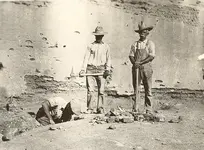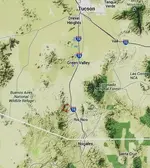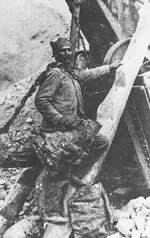Hello Roy
If the crick and the Lords willing, I'll see you there.
FEMF
If the crick and the Lords willing, I'll see you there.
FEMF
Postscript:
An excellent argument against Jesuit mines and treasures by father Charles Polzer, SJ, published in the Aug 1962 issue of Desert magazine:
http://mydesertmagazine.com/files/196208-DesertMagazine-1962-August.pdf
<it is a PDF file so you will need a program that can handle that file type, like Adobe Acrobat, and of course the article begins on page 22>
IMHO a poor argument, and one that is misleading and distorting.
Cunning and yet disingenuous of Polzer to equate site destruction with 'rumor of Jesuit treasures' despite a complete lack of evidence. His continual and persistent association of those two topics seemed to have been a remarkably successful strategy in causing academic or scientific circles to shy away from examining this issue too closely.
How is it known that the "destruction" wasn't natural, or engendered by any other cause than treasure-hunting? It was common in the early days for builders to "borrow" material from existing sites.
Polzer claims that he "wanted" the shovel to be in the hands of an archaeologist, but IMHO, that is the last thing he really wanted. In fact, I suspect he wanted the shovel to stay in the TH'er's hands as he knew they would never be taken seriously.

Deducer,
Here is where you are falling a bit short on local knowledge. What I can tell you from what I know about Tumacacori, is that before restoration, the walls had fallen down in some places from being undercut by treasure hunters. Here is an early 1900s picture of some proud treasure hunters trenching right up the the wall at Tumacacori:
Most of the destructive work was done in the early 1900s and during the depression. Polzer was not mistaken on this fact. There was a lot of damage done to several mission sites because of the Treasure Stories associated with them.
Mike
IMHO a poor argument, and one that is misleading and distorting.
Cunning and yet disingenuous of Polzer to equate site destruction with 'rumor of Jesuit treasures' despite a complete lack of evidence. His continual and persistent association of those two topics seemed to have been a remarkably successful strategy in causing academic or scientific circles to shy away from examining this issue too closely.
How is it known that the "destruction" wasn't natural, or engendered by any other cause than treasure-hunting? It was common in the early days for builders to "borrow" material from existing sites.
Polzer claims that he "wanted" the shovel to be in the hands of an archaeologist, but IMHO, that is the last thing he really wanted. In fact, I suspect he wanted the shovel to stay in the TH'er's hands as he knew they would never be taken seriously.
Report of the Governor of New Mexico to the Dept of the Interior, 1905, published in the US Congressional Serial set issue 4961, pp 523In the Cerrillos district are the Tiffany and other turquoise mines but it was through the discovery of sulphide ores zinc lead and silver that the district came into prominence in 1879. The following year two mining camps Bonanza and Carbonateville were laid out south of Santa Fe. In this district is the Mina del Tierra, the oldest lode mine in the West which was worked prior to 1680 by Indian slaves under the direction of the Jesuits It carries silver, lead, and zinc.
Hey here is one for our amigo Springfield:
In the Cerrillos district are the Tiffany and other turquoise mines but it was through the discovery of sulphide ores zinc lead and silver that the district came into prominence in 1879. The following year two mining camps Bonanza and Carbonateville were laid out south of Santa Fe. In this district is the Mina del Tierra, the oldest lode mine in the West which was worked prior to 1680 by Indian slaves under the direction of the Jesuits It carries silver, lead, and zinc.
Report of the Governor of New Mexico to the Dept of the Interior, 1905, published in the US Congressional Serial set issue 4961, pp 523
What do you make of that one? A mistake, intending to write Franciscans or perhaps wrote the wrong name, or...? Thank you in advance.
Roy ~ Oroblanco

Hey here is one for our amigo Springfield:
Report of the Governor of New Mexico to the Dept of the Interior, 1905, published in the US Congressional Serial set issue 4961, pp 523
What do you make of that one? A mistake, intending to write Franciscans or perhaps wrote the wrong name, or...? Thank you in advance.
Roy ~ Oroblanco

Roy
Let's face it.....When it comes to treasure hunting stories, the Jesuits are just way more sexy than the Franciscans.
Take care,
Joe
Are you contending that the governor of New Mexico, wrote "Jesuits" in his report, because the Jesuits are "more sexy"? Thanks in advance,
Oroblanco
Hi Roy,
Which governor are you referring to?
Take care,
Joe

I guess I don't get an answer this time.
 I wouldn't bet the farm on the details of the mine described in the previous link I provided.
I wouldn't bet the farm on the details of the mine described in the previous link I provided.
